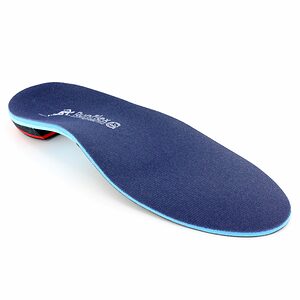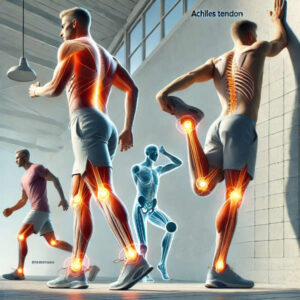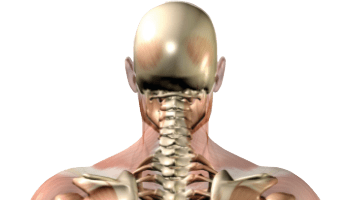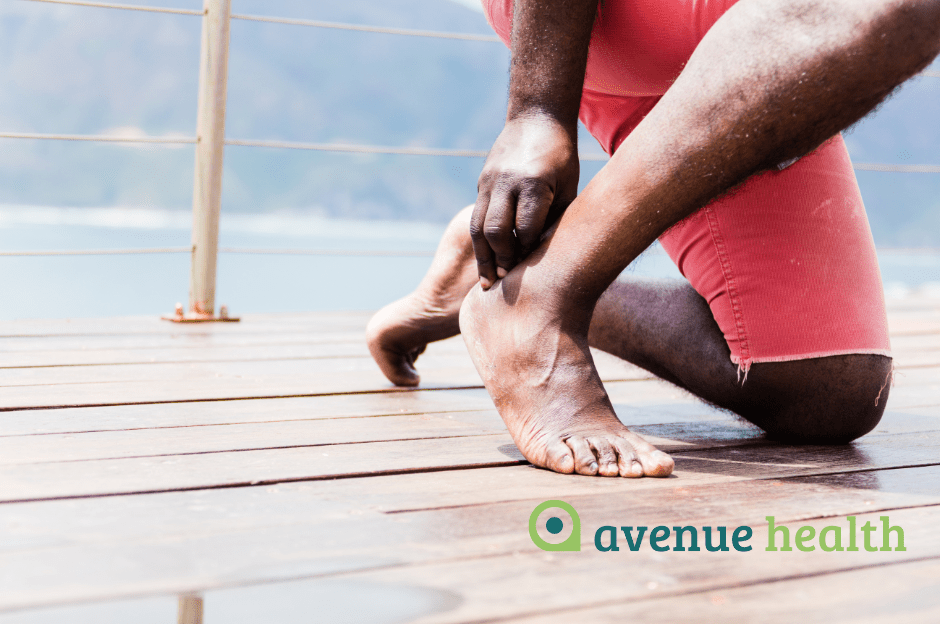Contents
- 1 What is Achilles Tendonitis?
- 2 What are the symptoms of Achilles Tendonitis?
- 3 How Can Shockwave Therapy Resolve Achilles Tendonitis?
- 4 How Can Orthotics Resolve Achilles Tendonitis?
- 5 Will Pain-Relieving Drugs Help With My Achilles Tendonitis?
- 6 Causes of Achilles Tendonitis
- 7 Preventing Achilles Tendonitis
- 7.1 1. Incorporate Proper Warm-Up and Stretching Techniques
- 7.2 2. Choose Appropriate Footwear
- 7.3 3. Gradually Increase Activity Levels
- 7.4 4. Strengthen Supporting Muscles
- 7.5 5. Monitor and Address Biomechanical Issues
- 7.6 6. Rest and Recover Properly
- 7.7 8. Be Mindful of Surfaces
- 7.8 9. Stay Hydrated and Maintain Overall Health
- 7.9 10. Seek Professional Guidance from Avenue Health
What is Achilles Tendonitis?
What are the symptoms of Achilles Tendonitis?
Common Symptoms
How Can Shockwave Therapy Resolve Achilles Tendonitis?
How Can Orthotics Resolve Achilles Tendonitis?

Get a 30-minute new patient assessment, diagnosis & treatment plan for just £35
I believe in alternative methods of treating back and foot problems and have done so for over 40 years. I’ve been treated by chiropractors, osteopaths and podiatrists whose methods are effective.
The difference between other practitioners and Michael Walker at the Avenue is that their prime objective is to see patients frequently so that they become more dependent on the course of treatments, whereas Michael’s ethos is to get his patients better quickly so that they become less dependent on his treatment.
Michael gets to the root of my problem and talks me through the possible causes of discomfort so I walk away having learned about the importance of posture, wearing the correct footwear and avoiding back and foot pain. Thank you, Michael!
Lesley Vaughan, Kingston-upon-Thames
Will Pain-Relieving Drugs Help With My Achilles Tendonitis?
Inflammation can be greatly reduced using NSAIDs (Non-Steroidal Anti-Inflammatory Drugs), such as ibuprofen, aspirin and paracetamol. Although they can reduce the inflammation caused by your Achilles Tendonitis, they do not address the underlying problem. They can, in some cases, cause stomach problems, such as acid reflux and constipation.
It is important not to use pain-killing drugs before engaging in physical activity. This is because, without feedback from your body’s nervous system, it is easy to over-use and further aggravate your condition. Remember: pain is the body’s way of telling you something isn’t right. However, when used correctly, painkillers are very useful in helping you get a good night’s sleep, which is a vitally important part of your recovery.
If you are already taking medication prescribed by a doctor, you should always ask the advice of a Doctor or Pharmacist before self-medicating, as some pain-killing drugs can affect the effectiveness of your medication, and can sometimes be dangerous.
Causes of Achilles Tendonitis
Achilles tendonitis occurs when the Achilles tendon, the largest and strongest tendon in the body, becomes inflamed or irritated. This tendon connects the calf muscles to the heel bone and plays a crucial role in activities such as walking, running, and jumping. Understanding the causes of Achilles tendonitis can help individuals identify contributing factors and take steps to prevent or manage the condition.
Overuse and Repetitive Strain
One of the most common causes of Achilles tendonitis is overuse. This occurs when the tendon is subjected to repetitive strain or excessive force, often during high-impact activities like running, jumping, or dancing. Athletes and individuals who engage in intense physical activity are particularly susceptible, especially if they do not allow adequate time for rest and recovery.
Sudden Increases in Physical Activity

A rapid increase in the intensity or duration of exercise can also lead to Achilles tendonitis. For instance, a runner who abruptly increases their mileage or a gym-goer who suddenly incorporates high-intensity exercises without proper conditioning may place undue stress on the tendon, causing irritation or micro-tears.
Improper Footwear
Wearing shoes that lack proper support or cushioning can contribute to Achilles tendonitis. Footwear with inadequate arch support or high heels, which alter the natural alignment of the foot, can place additional strain on the Achilles tendon. Over time, this can lead to inflammation and discomfort.
Biomechanical Issues
Biomechanical abnormalities, such as flat feet (overpronation) or high arches, can increase the risk of Achilles tendonitis. These conditions can alter the way weight is distributed across the feet, leading to uneven strain on the tendon. Muscle imbalances, tight calf muscles, and poor posture can further exacerbate the problem.
Age and Tendon Degeneration
As we age, the Achilles tendon naturally becomes less flexible and more prone to degeneration. This makes individuals over 30 more susceptible to tendonitis, particularly if they lead an active lifestyle. Degenerative changes in the tendon, known as tendinosis, can weaken its structure and increase the likelihood of inflammation.
Underlying Medical Conditions
Certain medical conditions, such as rheumatoid arthritis or diabetes, can predispose individuals to tendon problems, including Achilles tendonitis. These conditions may affect the body’s ability to repair damaged tissues or contribute to inflammation, making the tendon more vulnerable to injury.
Poor Warm-Up and Stretching Habits
Failing to properly warm up before exercise or neglecting stretching routines can increase the risk of Achilles tendonitis. A lack of preparation can leave the tendon and surrounding muscles tight, reducing their ability to absorb impact and leading to strain.
Environmental Factors
Running or exercising on hard or uneven surfaces can place additional stress on the Achilles tendon. Athletes who frequently train on concrete or steep inclines are particularly at risk. These conditions force the tendon to work harder, increasing the potential for irritation or injury.
Summary
Achilles tendonitis often results from a combination of factors, including lifestyle habits, physical activity levels, and underlying biomechanical issues. Identifying these causes is an essential first step in managing the condition and preventing its recurrence. By addressing modifiable factors such as footwear, training routines, and stretching habits, individuals can significantly reduce their risk of developing Achilles tendonitis.
Preventing Achilles Tendonitis
Prevention is key to avoiding the discomfort and limitations associated with Achilles tendonitis. While some risk factors, such as age or underlying medical conditions, cannot be controlled, several strategies can significantly reduce the likelihood of developing this condition. By adopting proactive habits and paying attention to your body’s needs, you can protect your Achilles tendon and maintain your mobility.
1. Incorporate Proper Warm-Up and Stretching Techniques
A thorough warm-up routine prepares your muscles and tendons for physical activity, reducing the risk of strain. Stretching exercises that target the calf muscles and Achilles tendon can improve flexibility and resilience. Examples include:
- Calf Stretches: Stand with one foot forward and one back, keeping your back heel on the ground. Lean into a wall or surface to stretch the back calf muscle.
- Dynamic Movements: Incorporate ankle circles, gentle heel raises, and other dynamic stretches to prepare the tendon for activity.

2. Choose Appropriate Footwear
Wearing supportive footwear tailored to your activity can prevent undue stress on the Achilles tendon. Look for shoes with:
- Adequate arch support to maintain proper alignment.
- Cushioning to absorb impact, especially during high-impact activities.
- A snug fit to avoid unnecessary movement within the shoe.
Replace worn-out shoes regularly to ensure consistent support.
3. Gradually Increase Activity Levels
Avoid sudden increases in exercise intensity or duration. Gradual progression allows your muscles and tendons to adapt to new demands, reducing the risk of overuse injuries. For example, follow the “10% rule” by increasing your weekly mileage or workout intensity by no more than 10%.
4. Strengthen Supporting Muscles
Strengthening the calf muscles and surrounding structures provides additional support for the Achilles tendon. Incorporate exercises such as:
- Calf Raises: Stand on the edge of a step and slowly raise and lower your heels.
- Eccentric Heel Drops: Similar to calf raises but focusing on the downward movement to build strength.
Strengthening the core and lower limb muscles can also enhance overall stability and reduce strain on the tendon.

5. Monitor and Address Biomechanical Issues
If you have biomechanical issues, such as flat feet or high arches, consider using orthotics. Custom insoles can help correct foot imbalances, ensuring even weight distribution and reducing stress on the Achilles tendon.
6. Rest and Recover Properly
Rest days are crucial for allowing the body to repair itself and prevent overuse injuries. Listen to your body and avoid pushing through pain, as this can exacerbate strain on the tendon.
7. Cross-Train to Avoid Repetitive Strain
Engage in a variety of activities to minimise repetitive strain on the Achilles tendon. For instance, alternate between running, swimming, and cycling to vary the muscles used while maintaining fitness.
8. Be Mindful of Surfaces
Running or exercising on hard or uneven surfaces can place additional stress on the Achilles tendon. Opt for softer surfaces, such as grass or track, when possible. If training on uneven terrain, adjust your pace and focus on proper form.
9. Stay Hydrated and Maintain Overall Health
Hydration supports tissue elasticity and reduces the risk of injury. Coupled with a balanced diet rich in vitamins and minerals, it ensures that your tendons receive the nutrients needed for repair and resilience.
10. Seek Professional Guidance from Avenue Health
If you are prone to injuries, experiencing recurring pain, or unsure about your training routine, seeking expert guidance is essential. Avenue Health, with clinics in Cheam, Worcester Park, and Surbiton, specialises in treating musculoskeletal conditions, including Achilles tendonitis or Achilles tendon pain.
Our team of experienced osteopaths provides personalised assessments and tailored treatment plans to help you recover and prevent future issues. Whether you need guidance on strengthening exercises, orthotic solutions, or advice on managing pain, Avenue Health is here to support you every step of the way. Our advanced diagnostic tools and therapies, including shockwave treatment, ensure that you receive the highest standard of care.
Take the first step towards protecting your Achilles tendon and maintaining your active lifestyle by booking an appointment at Avenue Health today.



